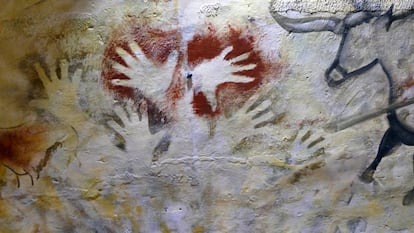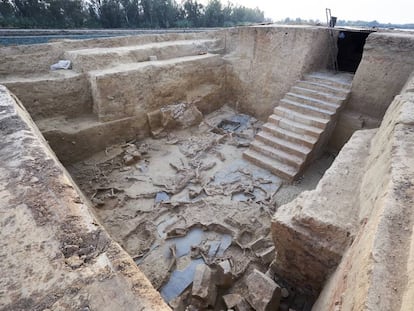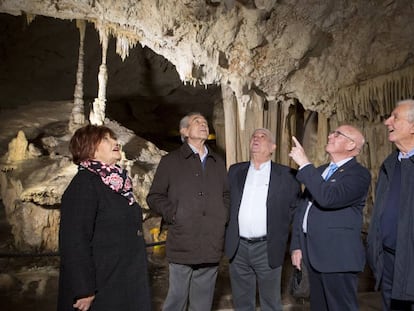Three new prehistoric hand prints found inside Altamira cave in Spain
The art, which is in bad condition, was identified during the course of inventory work inside the world-famous Paleolithic site

Members of the Museum of Altamira’s research team and managers of the Handpas project, a venture that documents and spreads images of Paleolithic hand representations in Europe, have found three new hand prints on the walls of Altamira cave, in Spain’s northern Cantabria region, that “almost certainly” were done more than 20,000 years ago.
The three new hand prints were done “almost certainly” more than 20,000 years ago
These three painted hands, which are in bad condition, add to the six that were already known to exist, and were identified during the course of some documentary and inventory work on the other drawings inside the world-famous cave.
After they were discovered, the hands were digitally photographed and added to Handpas’ 3D catalogue of Paleolithic hands in Europe. The collaboration between the project and the museum was announced by Pilar Fatás, director of Altamira Museum, by her deputy Carmen de las Heras, and by the director of Handpas, Hipólito Collado, who is also head of the archeology department of the regional government of Extremadura.
Eight of the painted hands are located on the ceiling of Sala de Polícromos (Polychrome Room), between horse representations, and the other one is in the Galería Final, the furthermost space located over 200 meters from the cave mouth. This particular work of art, whose existence had been known since the 1980s, but which had not been properly analyzed, is different from the rest. Apart from being a print rather than a stencil, meaning that the full hand was painted and used to make a print, it is also the hand of a child. Painted a deep black, it is “quite exceptional,” as very few hands of this size have been documented, says De las Heras.
According to analysis, 70% of the prehistoric population was right-handed
The others, located in the Polychrome Room, vary in color, ranging from a dark violet to an intense red. Although it is not known for sure, De las Heras believes that the hands are superimposed on the images of horses. According to data obtained and analyzed by Collado, 70% of the prehistoric population was right-handed.
The importance of the finding does not lie in the number of prints discovered, but rather in the way that they illustrate what the Polychrome Room looked like before the famous bison painting, says De la Heras. “Thirty-two years after the last publication on the art of Altamira, the cave continues to produce relevant findings that never cease to amaze us and show us its greatness,” she says.
The Museum of Altamira has showcased a documentary called Handpas, manos del pasado (Handpas, hands of the past), which aims to provide answers to many of the questions raised by the prehistoric art. The documentary has been shown at multiple international science film festivals.
English version by Asia London Palomba.
Tu suscripción se está usando en otro dispositivo
¿Quieres añadir otro usuario a tu suscripción?
Si continúas leyendo en este dispositivo, no se podrá leer en el otro.
FlechaTu suscripción se está usando en otro dispositivo y solo puedes acceder a EL PAÍS desde un dispositivo a la vez.
Si quieres compartir tu cuenta, cambia tu suscripción a la modalidad Premium, así podrás añadir otro usuario. Cada uno accederá con su propia cuenta de email, lo que os permitirá personalizar vuestra experiencia en EL PAÍS.
¿Tienes una suscripción de empresa? Accede aquí para contratar más cuentas.
En el caso de no saber quién está usando tu cuenta, te recomendamos cambiar tu contraseña aquí.
Si decides continuar compartiendo tu cuenta, este mensaje se mostrará en tu dispositivo y en el de la otra persona que está usando tu cuenta de forma indefinida, afectando a tu experiencia de lectura. Puedes consultar aquí los términos y condiciones de la suscripción digital.
More information
Archived In
Últimas noticias
Pinochet’s victims grapple with José Antonio Kast’s rise in Chile
Reinhard Genzel, Nobel laureate in physics: ‘One-minute videos will never give you the truth’
How Japan is trying to avert ‘digital defeat’
The complicated life of Francesca Albanese: A rising figure in Italy but barred from every bank by Trump’s sanctions
Most viewed
- Pablo Escobar’s hippos: A serious environmental problem, 40 years on
- Why we lost the habit of sleeping in two segments and how that changed our sense of time
- Charles Dubouloz, mountaineering star, retires at 36 with a farewell tour inspired by Walter Bonatti
- Trump’s obsession with putting his name on everything is unprecedented in the United States
- The Florida Keys tourist paradise is besieged by immigration agents: ‘We’ve never seen anything like this’










































